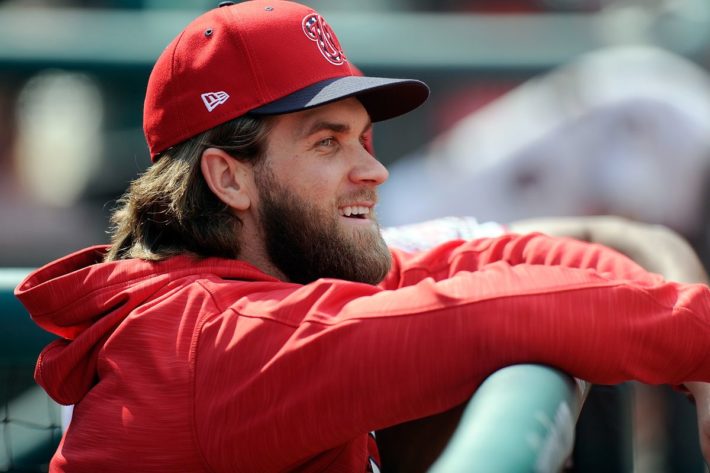Who is Bryce Harper? Well, he first appeared on the cover of Sports Illustrated when he was 16, which created a circus of hype about his impending stardom. Because of that early attention, he’s one of the few baseball players with name cachet outside of the sport, which is one reason his free agency is being followed with such intense interest. Plus, he’s a guy with great hair. He’s not the best player in the game, but he’s arguably the most famous.
Harper finished high school a year early, spent a year in junior college, was the first overall pick by the Nationals in the 2010 draft, reached the majors at age 19 in 2012, won the National League MVP award in 2015 and enters free agency at 26. He’s in the prime of his career, not always the case for a prestige free agent, and that makes his free agency even more intriguing. You’re not betting on a 30-something star to defy the aging curve in the later years of the contract; if you sign Harper, you’re expecting a long run of excellence.
With that mind, here are some questions and issues to consider …
What kind of contract will Harper receive?
At the general managers meetings in early November, Nationals GM Mike Rizzo said he made an offer to Scott Boras, Harper’s agent, late in the season — a reported 10-year, $300 million offer. That figure could be considered a baseline, although it does come with a couple of caveats:
1. Rizzo would have known there was no way Harper and Boras would take that deal at that point in the season, so his public revelation of the offer was really more about telling the fans, “Hey, we tried to give him $300 million, so we tried to sign him.” It’s easy to throw that out there when you know it’s not going to be accepted. What we don’t know is if that offer is still on the table.
2. We don’t know the details of the offer. Were there opt-out clauses? Was a bunch of the money deferred, as is the case in Max Scherzer’s contract? Was there a signing bonus or team or player options?
Anyway, $300 million is a starting point on a long-term deal for Harper. Maybe it gets up to $350 million. It probably won’t be the $400 million or $500 million that seemed possible or even likely after his MVP season. It could include some crazy opt-out options, even after one or two seasons. The largest contract in MLB history is Giancarlo Stanton’s 13-year, $325 million deal signed with the Marlins. You know Boras wants to beat that.
Which teams are the possible fits?
The two ways to look at this: Who needs a power-hitting corner outfielder with a high on-base percentage? And who can afford him?
Here are the teams with the worst right-field production in the majors in 2018:
Diamondbacks: .273 wOBA (weighted on-base average)
Angels: .283 wOBA
Orioles: .304 wOBA
White Sox: .307 wOBA
Phillies: .311 wOBA
Cardinals: .311 wOBA
We can cross off the Diamondbacks and Orioles from that list. The Angels do have Kole Calhoun in right field (and Justin Upton in left) and have to re-sign Mike Trout in two years (or hope to re-sign him), so they seem unlikely.
The White Sox, Phillies and Cardinals are possible fits. We already know the Phillies are in hot pursuit of Harper and Manny Machado. They were also interested in Patrick Corbin, but the Nationals just signed him, so that should increase their desire to add a big bat, no matter the price. Earlier in the offseason, Phillies owner John Middleton said he’s ready and willing to spend big in free agency, infamously adding “and maybe even be a little bit stupid about it.”
The Cardinals are known for being fiscally prudent, but they’ve also gone three straight seasons without making the playoffs, which hadn’t happened to them since 1997-99. They have right-field options, but the feeling is they need to add a star bat to a good-but-not-great lineup. Their projected payroll right now is about $136 million, compared to a $160 million Opening Day payroll last season. They have room to make a big splash.
The White Sox are clearly a dark horse, but their projected payroll sits it a lowly $53 million. They need some star power. Owner Jerry Reinsdorf used to spend on free agents. One big hiccup: There is long-standing animosity between Reinsdorf and Boras.
The teams with the worst left-field production:
Giants: .275 wOBA
Tigers: .275 wOBA
White Sox: .304 wOBA
Reds: .308 wOBA
Royals: .308 wOBA
The Giants would seem to be a possibility. We know they made a pitch to acquire Stanton last offseason. They have deep pockets. They also have a deep power alley in right-center that would cut into Harper’s home run totals. The Tigers are rebuilding and unlikely to spend any major cash for another couple of years.
Worth noting: Also in the bottom 10 were the Rangers, Astros and Rockies. I would love to see Harper go to Colorado to see what a proven hitter could do in the thin air. Those wOBA figures aren’t park-adjusted; if they were, the Rockies would fall even further. Both their left fielders and right fielders ranked in the bottom six in the majors in WAR. The Rockies, however, would prefer to re-sign Nolan Arenado. Denver would be a short flight to Harper’s hometown of Las Vegas though.
The Rangers move into a new park in 2020 and have deep pockets, but they also have Joey Gallo and Nomar Mazara locked in at the outfield corners and seem a couple of years away from a potential competitive window. The Astros are probably a long shot, but you can see the fit: They need a left-handed bat in a lineup that scored 99 fewer runs last season than in 2017 and do have some room to spend. They also need to find some starting pitching and might instead look to upgrade first base or DH with a long-term commitment.
What about the Dodgers and Yankees?
We can’t ignore these two franchises. Under Andrew Friedman, the Dodgers have been reluctant to give out huge free-agent contracts, but Harper’s relative youth perhaps makes him the target the Dodgers would be willing to spend big on. Outfield isn’t an obvious need, but they could clear right field by trading Yasiel Puig, who is in his final season before free agency.
The Yankees have a more crowded situation, with Stanton already signed through 2027 and Aaron Judge locked into right field. Having two corner outfielders signed to megadeals feels a little risky — and that’s before Judge’s future comes into play — but money shouldn’t stop the Yankees. They also re-signed Brett Gardner to a one-year deal. I don’t really see an issue here, if the Yankees really want Harper — especially knowing he’s the perfect fit for the short porch in right at Yankee Stadium. Adding Harper simply means five guys for four positions (along with center fielder Aaron Hicks). That’s still plenty of playing time for everybody.
The Yankees didn’t get Corbin. We know they’re going to spend on somebody this offseason. Maybe Machado is the better fit given the roster needs, but the Yankees could use a lefty bat to help balance out Stanton, Judge, Gary Sanchez, Gleyber Torres and Miguel Andujar, all right-handed hitters. Maybe that makes Harper a better fit than Machado.
What about the Cubs?
The Cubs have a crowded outfield picture with Kyle Schwarber, Albert Almora and Jason Heyward, plus Ian Happ and Ben Zobrist getting time out there. They’re already over the luxury tax, supposedly one reason they didn’t re-sign reliever Jesse Chavez, who went to the Rangers on a two-year, $8 million deal. Still, Harper is buddy-buddy with Kris Bryant, his pal from Vegas, and a report Tuesday in The Athletic said Theo Epstein and Jed Hoyer are expected to “check in” on Harper as he meets with teams.
So the chances seem slim, except … well, for one thing, the Cubs are printing money these days. They clear a lot of room off the payroll after this season (Cole Hamels at $20 million, Zobrist at $12.5, a bunch of relievers at around $30 million combined, Jose Quintana if they don’t pick up his option). They could trade Schwarber to open up left field. So don’t count out the Cubs, especially given the way the offense collapsed down the stretch.
Is Harper worth $300 million?
That’s kind of an important question and one that has been glossed over. Here’s a quick little comparison. Eight position players entering their age-27 season (or younger) have signed long-term deals worth at least $150 million. They weren’t all free agents — some signed extensions before hitting free agency — but it’s interesting to compare Harper to these nine:
As you can see, Harper’s WAR over the past three years isn’t in the same vicinity as the other young stars. Via Baseball-Reference, over the past three seasons, Harper ranks 85th among position players in WAR — tied with Scooter Gennett, who nobody is suggesting is a $300 million ballplayer. Now, B-R docks Harper quite a bit for his defense, especially in 2018. OK. FanGraphs evaluates him with more kindness, with a three-year cumulative WAR of 11.2, 34th among position players. That would still place him ninth among the nine players listed above.
The enticing part of the Harper equation, however, lies in that final column: His career-high WAR of 10.0. That came in his MVP season four years ago, when he hit .330/.460/.649 for an insane OPS+ of 198, played good defense and for one season did indeed rival Mike Trout as the best player in the game.
Over the past three seasons he has hit .267/.391/.505, including .249/.393/.496 in 2018. It took a second-half surge just to get those numbers, as he hit .214 in the first half. We’ll dissect Harper’s hitting at some point later in the offseason, but suffice it to say: There’s a lot of volatility in his future production.
There is some safety here in his profile: He’s going to hit home runs and his high walk rate means he’s getting on base even with a low average. The defensive issues in 2018 are a concern, but there’s some feeling he was maybe bothered by the knee injury suffered in 2017 (and there’s little doubt that he played it cautious out there in order to avoid injury). But he also misplayed some routine plays and recorded just one assist.
Maybe we’ll never see that 2015 season again, but the signing team will at least hope he settles in at something close to his 2017 level — a 6.4 WAR pace over 150 games (he played 111 games due to the injury).
Who are the favorites?
These predictions rarely go as expected, but I rank it as Phillies, Dodgers, Yankees, Cardinals, White Sox. The Corbin signing drops the odds of a return to the Nationals. Sleeper team: the Astros.
Which means he’ll probably sign with the Padres.
Will he sign at the winter meetings in Las Vegas next week?
It would be a storybook announcement to push Harper into the spotlight in his hometown, but it’s very unlikely. Consider the signing dates of Boras’ big free agents last year: Eric Hosmer on Feb. 18, J.D. Martinez on Feb. 26 and Jake Arrieta on March 12. Boras isn’t going to rush a deal just to get it done in Vegas.

